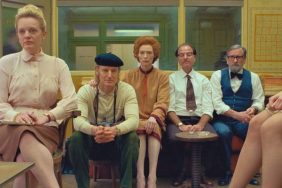Prologue: On Sunday, The Artist won the Academy Award for Best Picture. The Artist was produced by a man named Harvey Weinstein, whom you’ve probably heard of. Harvey Weinstein is one of the more powerful producers in Hollywood, and co-founded one of the major studio players, Miramax Films, in the 1980s. Weinstein is known for not only his business savvy, and his bullish behavior at film festivals, but for his ancillary connection to hugely ubiquitous ad campaigns surrounding certain Best Picture hopefuls. Of the films he produced or executive produced, many have been nominated for Best Picture and several (Shakespeare in Love, Slumdog Millionaire, The English Patient, Chicago, The Lord of the Rings: The Return of the King) have won.
Welcome back, my lovely young students (especially you), to another go ’round through the knowledge centrifuge that is CraveOnline‘s Free Film School. I am your humble professor, Witney Seibold, here to take your hand, and lead you down the myriad paths of the world of cinema. Today’s lesson is going to be on a chapter in film history that many of you may remember, and shaped the way movies were made for decades. We’re going to cast our minds back all the way back to 1989, and look at a movement of film that is still kicking today, and is still cutely nicknamed in trade papers. We’re going to look at Indie Film.
“Indie” film is, of course, merely shorthand for “independent” film. When one refers to independent movies, one talks about feature films that are financed and filmed largely outside of the aegis of major Hollywood studios. A studio may buy a completed film and distribute it themselves, but hardworking filmmakers, often working for free, will often be the ones that complete these movies. These are independent productions. The actual content, length, star power, ad campaign or success of a film has no bearing on its independent status. Some independent films are, indeed, more expensive and high-profile than certain studio films. Big stars can star in them, and recognizable directors can make them. The term “independent” refers only to its production system, and where the money came from.
Indeed, the practice of making films outside of the studio system is hardly new. It’s been going on for as long as there have been studios to work outside of. The rise of the studio system is the topic for another Free Film School lecture. But even in the early days of cinema, many artists felt stifled by the constraints and creative interference from paranoid moneymen. Some powerful industry insiders decided to fight this by forming The United Artists (which I talked about in my lesson on Mary Pickford). Eventually, United Artists proved to be just another big studio, but at its inception, it was intended to be an outlet for independents. It wasn’t until camera technology became streamlined and cheaper (sometime around WWII) that independent films as we define them came into being. Filmmakers began cropping up everywhere. And since there were also independent theaters back in that time, many ambitious filmmakers could shoot a film and then sell it directly to a theater, making for a guaranteed theatrical run.
True, this allowed for hundreds of thousands of cheap exploitation films to be cranked out at the slightest whim, but it also allowed ambitious experiemntal filmmakers like Maya Deren and Kenneth Anger to enter the scene. Some of those two filmmakers’ work helped fuel the French New Wave some 15 years later, which would, in turn, inspire the American film boom in the 1970s. In the 1970s, you’ll find that a lot of well-known and highly respected and successful movies were independently produced. Easy Rider, Midnight Cowboy,and Apocalypse Now were made outside the studio system, to cite a few at random. Bonnie and Clyde, funded largely by star Warren Beatty, was probably the film that started the “film school generation” mindset that would dominate the ’70s. There was even a time when Lucasfilm was considered an “independent” studio.

Throughout the 1980s, the film world became increasingly commercial and streamlined, however, and the entire decade was marked by a particular brand of commercialism. Many independent films came out during this time, of course, and underground counterculture and punk films were crawling around out of the public eye. (If you can, for instance, find a Troma movie, or the films of Nick Zedd at your local video store, rent them. I recommend The Class of Nuke ‘Em High and They Eat Scum respectively.) But, for the most part, the 1980s were better known for their blockbusters. Any Gen-Xer or Gen-Yer probably owns films like Back to the Future and Ghostbusters on home video. If you can, find film criticism from the 1980s. Read some Pauline Kael. You’ll find a general dissatisfaction with mainstream Hollywood features. Any decade that can produce Harry and the Hendersons has little in the way of defense.
So by 1989, something significant happened in the film world, to shake up everything. In 1989, Steven Soderbergh, then largely unknown, released the unconventional relationship drama sex, lies, and videotape onto the world. The film itself, when viewed today, feels a mite dated, and perhaps a bit too angsty for its own good. It follows the adventures of a quartet of thirtysomethings as they struggle, very vocally, through their sexual strife. Andie McDowell and Peter Gallagher have an unexciting sex life. The beatnik-like hep cat James Spader has developed a sociological interest/fetish of filming people’s personal confessions on video. He’s impotent. Laura San Giacomo is in there as well. The four of these all come to explosive understandings about themselves.

In an age of slasher sequels and Ernest Goes to Camp, a film like sex, lies, and videotape seemed revolutionary, and it became a huge hit. The film was produced by – you guessed it – Harvey Weinstein, and it catapulted Miramax into the public consciousness in a dramatic fashion.
Thanks to the success of sex, lies, and videotape, independent films boomed larger than they ever had. Even bigger than they did in the 1970s. The thought of independent productions became alluring to investors, and, again, most anyone could make a cheap, soulful, meaningful film that would, perhaps, get mass consumption in a previously limited market. Audiences and trades became so familiar with this movement, they dubbed it “Indie.” Indie film is still a term used today.

The Indie films of the ’90s were further bolstered by the success of foreign films like Cinema Paradiso, well-acted English-language imports like My Left Foot and The Crying Game, and Michael Moore’s documentary Roger & Me. These films were seen nationally, and some won Academy Awards. Miramax films of the early 1990s were of a very distinct flavor. Costume dramas made a resurgence, but often edgier versions than previously produced (no other period, for example, could have produced a film like Sally Potter’s Orlando). Peter Greenaway’s absurdist, nudity-loaded cannibal-themed absurdist pseudo-classic The Cook, The Thief, His Wife, and Her Lover came out during this time. New directors started gaining familiarity. Alongside Soderbergh, peers like Spike Lee, Kevin Smith, Richard Linklater, Allison Anders, Jim Jarmusch, Hal Hartley, Gregg Araki, Harmony Korine, and even John Sayles started emerging as important new artists. I don’t have time here to list all of these people’s filmographies, so I encourage you to look them up yourselves. You’ll find some really impressive and striking films in there.
The boom was everywhere. Art theaters became to re-emerge in the American landscape during this time. Some major theater chains began to specialize in this new indie and foreign market. I work at one. Video stores also exploded with hard-to-find titles that were gaining a lot of publicity. Films like The Full Monty and The Shawshank Redemption, acquired from indie markets, only became the enormous hits they’re known to be once they hit video. Well, Monty was kind of a sleeper hit in big cities already.
Queer films also made a boom during the era, but that’s so varied and textured a topic, it will have to wait for a future Free Film School lecture as well.

Oh, and let us not forget Quentin Tarantino. In 1994, Miramax released Pulp Fiction onto the world, and nothing would ever quite be the same. Tarantino already had a hit with Reservoir Dogs two years previous, but Pulp Fiction became a success even larger than the other films mentioned. Its extreme style and use of violence sparked debates across the country. Its popular abandonment of an chronological narrative rattled film schools. Students began enrolling in film programs in droves, all hoping to be “the next Tarantino.” In hopes of imitating the film’s success, studios started to produce scuzzy, casually violent crime films by the dozen. One imitator was good. Watch Get Shorty sometime. It was put out by MGM/UA.
This next point may seem a bit dry, but it is hugely significant. When major studios saw that filmmakers could have huge successes outside of the system, they didn’t fight them off, but bought in. Major studio players spent millions upon millions of dollars for this new market. Disney famously acquired Miramax as early as 1993. According to some internet research, I learned that the reported price was $60 million. And while Disney could dictate which films could and couldn’t be released (there was a lot of controversy over the sexually explicit 1995 teen apocalypse film Kids), they largely left Harvey Weinstein to operate the company as he saw fit.

From there, it was a free-for-all, and “co-financing” became the word of the day. Huge studios acquired smaller ones, and some launched indie branches for themselves (you’ll see names like Paramount Vantage and Fox Searchlight stalking around). Major studios would often give advertising and backing to indie productions again. This happens frequently today, but it wasn’t until the mid-1990s that this practice began in earnest. Until then, it was a rare, rare thing to see studios mix. Big studios were very protective of their product, and were hugely concerned with what films bore their label. It was an exclusive club, and major studios would not swim in the same pools. These days, studios mix all the time. Sometimes three or four major studios will back a film already funded by three or four smaller ones. Everyone wanted a piece of the pie.
Co-financing is now an inextricable part of the business. Studios like it because it lessens financial burden, and shifts failure away from them. It also means that they’ll be willing to take a risk, sometimes, on edgier fare.
But how well does that work? If a young, ambitious filmmaker has a very good film in their hands, but they have to contend with not just one studio, but several, how many levels of corporate approval do you think that filmmaker needs? How many “suggestions” can the producers make that would alter your film? How many producers are there now? Probably hundreds. One studio’s interference must be bad enough. Four or five could only serve to hinder you beyond what is healthy for anyone.

Since the home video market is currently limping thanks to online streaming services, indie films have experienced another schism. Some indie films are now only handled by big studios, and only have big stars. Many indie films are indistinguishable from major studio product. Technically, Red Tails was an indie film. What does this say to ambitious young filmmakers? Well, it’s a much more cutthroat world now. Your indie film has to compete in an even market with major studios leaking in at every opportunity. Many young filmmakers are making online-only digital films with newly inexpensive digital cameras. I heard a story of someone who shot an entire feature on their telephone. The indie film has, like in the 1980s, moved underground again.
Perhaps someday it shall re-emerge. But we’ll never have another indie epoch like in the 1990s.
Homework for the Week:
Watch a Miramax film from the 1990s. Any one will do, really, but if you want a great one, start with Three Colors: Red. If you haven’t seen Pulp Fiction yet, now is the time. Compare what you see to a film that has a much larger budget. How do they differ? What kind of film can you make for little money that you couldn’t with a lot? What is the difference in content of a ’90s indie film and a major studio film? Does a big budget and major stars change how you think about a film’s content? If you are a young and ambitious filmmaker, would you rather operate with a large budget and studio control, or would you prefer to make edgier and more personal film with less money? Which would you rather see?








